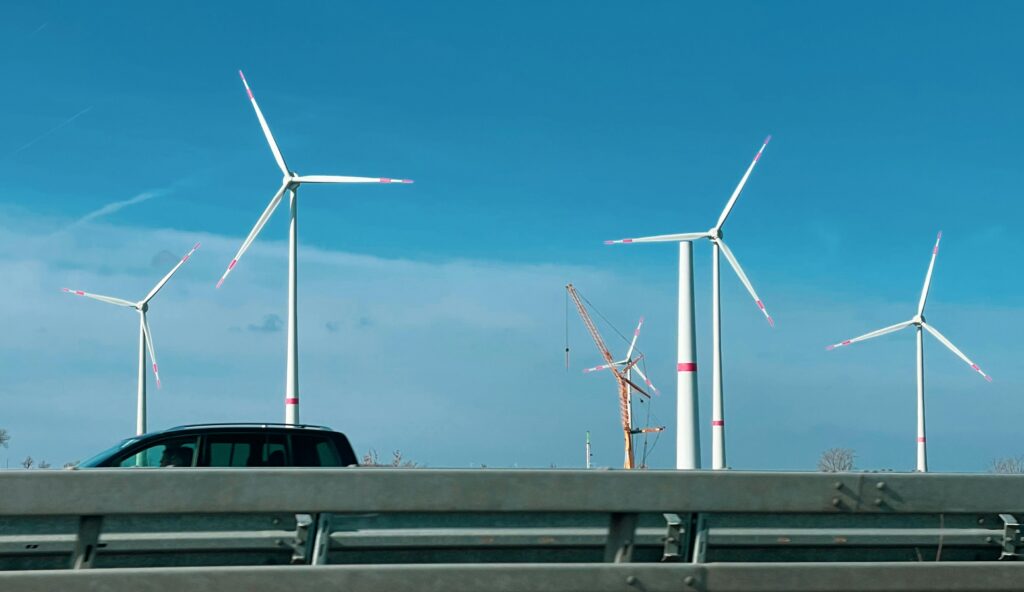The Future of Solar is Urban, Integrated, and Intelligent
Urban energy needs are growing, and solar technology is evolving to meet the challenge. In 2024, advances in material science and grid infrastructure are reshaping how cities generate, store, and use solar power. This isn’t just rooftop solar—it’s a full-system rethink of how energy can be captured and circulated in complex, high-density environments.
Next-Gen Photovoltaic Materials
New solar materials are pushing efficiency boundaries while opening up aesthetic and architectural possibilities.
- Perovskite solar cells offer a lightweight, cheaper, and more flexible alternative to traditional silicon-based panels, with conversion efficiencies rivaling or even surpassing older technologies.
- Bifacial solar panels can capture sunlight on both sides, increasing energy yields—especially in environments with reflective surfaces, such as urban rooftops or snowy regions.
Building-Integrated Photovoltaics (BIPV)
Solar is no longer just an add-on. It’s being designed as part of the structure itself.
- BIPV systems integrate photovoltaic materials directly into building components like windows, walls, and roofs.
- This approach minimizes space usage while offering sleek, seamless designs.
- Architects and developers are now incorporating BIPV into new builds, transforming the look and functionality of city skylines.
Smarter Grids and Energy Storage
The solar revolution isn’t just about generation—it’s also about how power flows between producers and consumers.
- Smart solar grids allow real-time monitoring and dynamic distribution of energy based on demand.
- Advanced energy storage, including lithium and emerging solid-state batteries, ensures consistent output even when the sun isn’t shining.
- Integrated systems help reduce strain on centralized grids while increasing resiliency during peak usage or blackouts.
Real-World Impact: Solar in Dense Urban Communities
Urban solar initiatives are yielding tangible results:
- In cities like Amsterdam and Tokyo, entire residential blocks are now powered using BIPV and micro-grid systems.
- Community solar hubs are emerging in underserved neighborhoods, offering shared access to clean energy.
- These innovations aren’t just about sustainability—they’re about energy independence, cost savings, and local resilience.
The takeaway? Solar is becoming more urban, more intelligent, and more embedded into the fabric of daily life. Cities aren’t just adopting solar—they’re being redesigned by it.
Introduction
Vlogging hasn’t just survived the last few years—it’s quietly adapted and evolved. While digital platforms tossed out curveballs and audience behaviors morphed overnight, creators who stayed flexible continued to thrive. Whether it was algorithm shifts, monetization changes, or the flood of short-form content, vlogging pushed forward.
Now 2024 signals a more intentional chapter. Platforms are changing what they reward, audiences are craving more authenticity, and content creation is becoming more tactical. It’s no longer just about going viral—it’s about showing up with purpose. For creators looking to grow, it’s time to get clear on what’s really working, what’s being left behind, and how to move smarter in a landscape that doesn’t sit still.
Floating offshore turbines are pushing the boundaries of where wind energy can work. Unlike traditional turbines that are fixed to the seabed, these floating systems can be placed in much deeper waters—where wind speeds are often stronger and more consistent. They’re unlocking areas that were previously off-limits, making room for major scale without competing for space on land.
AI is stepping in to help too. Advanced analytics are now helping engineers pinpoint the best spots to plant these turbines, factoring in everything from wind patterns to marine traffic. It’s more precision, less guesswork. The tech also fine-tunes how turbines operate once they’re running, squeezing out extra efficiency that adds up fast.
Onshore, vertical axis turbines are showing up in new places—tight urban corners, low-wind regions, rooftops. They’re not as efficient as their giant cousins, but they’re quieter, more compact, and way easier to integrate into dense neighborhoods or remote zones where big rigs can’t reach.
Taken together, these advances are making wind power more flexible. It’s no longer just a rural or coastal game. With better tools, smarter analysis, and a more modular approach, wind is scaling up in places the old model could never touch.
Beyond Lithium: The Storage Revolution Powering Green Energy
Lithium-ion batteries have carried much of the renewable load so far. But in 2024, storage tech is moving well beyond those old cells. Solid-state batteries are edging closer to real-world deployment—with better safety and energy density. Zinc-air and flow batteries are picking up steam too, especially in scenarios where cost and longevity matter more than portability.
Then there’s the grid. Solar and wind don’t always show up when you want them to. That’s why grid-level storage is becoming not just helpful—but essential. New battery tech is being built straight into decentralized energy systems, letting neighborhoods capture and reuse their own power. That means fewer blackouts, flatter demand curves, and a more stable transition off fossil fuels.
Here’s the bottom line: every improvement in storage lifts the entire clean energy ecosystem. Powerful home batteries, better EV range, dependable grid backups—all of it stacks up. Storage innovation isn’t just about better tech. It’s about speeding the shift, making green energy practical, local, and always available.
Decentralized Energy & Smart Consumer Control
The way energy is generated, distributed, and controlled is transforming. Consumers are no longer just users—they’re becoming active participants in the energy flow. Thanks to advanced technologies like blockchain and AI, a new era of decentralized power, consumer autonomy, and responsive automation is taking shape.
Microgrids & Peer-to-Peer Energy Trading
Energy no longer needs to come solely from massive centralized systems. Microgrids allow communities and neighborhoods to generate and manage their own energy locally.
- Microgrids: Small-scale, localized energy grids that can operate independently from the traditional grid
- Peer-to-peer energy trading: Consumers can sell excess solar or battery energy directly to neighbors
- Encourages resilience, lowers transmission loss, and empowers households to take control
Enabling Technologies: AI & Blockchain
Behind the scenes, AI and blockchain are making these decentralized systems possible and efficient.
- Artificial Intelligence (AI) predicts energy usage patterns, regulates distribution in real-time, and improves grid management
- Blockchain ensures secure, transparent energy transactions between peers
- These tools minimize waste, prevent fraud, and optimize pricing structures
Rise of the Prosumer
The line between producers and consumers is officially blurred. This “prosumer” mindset emerges as consumers use tech to manage how they generate, store, and distribute energy.
- Homeowners with solar panels feeding surplus power back into the grid
- App-based dashboards showing real-time data on energy usage and savings
- Increased control builds trust and drives smarter energy habits
Voice Interfaces & Automation Take the Lead
Smart homes are becoming energy-aware thanks to voice and automation.
- Voice-controlled assistants are now integrated with home heating, lighting, and EV charging systems
- Automation tools react to weather data, occupancy rates, and real-time pricing
- Improves both efficiency and convenience for users
For deeper insights into how voice tech is shaping energy user experiences, check out this relevant read.
In Summary
The next generation of energy systems prioritizes decentralization, transparency, and user empowerment. With smart tech in the driver’s seat, consumers are becoming full participants in the energy ecosystem—trading, saving, and managing with greater ease than ever before.
Electrolysis Tech Is Getting Smarter and Cheaper
It’s not just hype—electrolysis tech is finally hitting its stride. New designs and smarter systems are cutting costs, boosting efficiency, and opening the door to large-scale green hydrogen production. We’re talking about faster setups, lower electricity use, and modular designs that can scale without crushing your budget.
That’s changing the game across sectors. Heavy industry is lining up, especially in steel and cement, where emissions are hard to dodge. Aviation and long-haul transport? They’re eyeing hydrogen and synthetic fuels that start with clean electrolysis. It’s getting real—real fast.
Hydrogen hubs are popping up near ports, industrial zones, and even deserts with endless sun. These regional networks are building pipelines, storage, and export pathways—with green ammonia as the global shipping option. Japan, South Korea, and parts of the EU are locked in, looking to import by the gigaton.
Still, roadblocks remain. Infrastructure is patchy, and clean hydrogen lacks a universal stamp of approval. Whether it’s certification standards or policy bottlenecks, clarity matters. Without it, investors stall and projects gather dust.
The tools are there. The use cases are clear. Now it’s about wiring it all together—smart, fast, and clean.
Looking Ahead: The Tech That Will Shape Vlogging’s Future
The next wave is already on the radar. AI won’t just be for editing anymore—in five years, expect real-time translation, personalized content recommendations, and automatically generated visual FX at the push of a button. 5G (and the eventual rise of 6G) will make livestreaming smoother and more immersive, even for creators shooting in remote places. Augmented reality filters are only getting smarter, turning simple vlogs into hybrid experiences that blur the line between your phone screen and the world around it.
But it’s not just flash and upgrade cycles. Privacy-driven algorithms are coming, forcing creators to rethink how they earn trust and engagement. There’s real tension between automation and authenticity. Those who learn to keep their human voice—while using these tools wisely—will outlast trends.
Bottom line: progress isn’t passive. You don’t wait for it. You shape it. Adopt early. Experiment smart. Stay nimble. Because the future doesn’t wait for anyone who’s standing still.


 Senior Design Analyst
Senior Design Analyst
